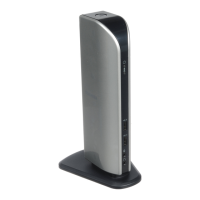
Do you have a question about the Toshiba PA3575U-1PRP dynadock U and is the answer not in the manual?
| Brand | Toshiba |
|---|---|
| Model | PA3575U-1PRP dynadock U |
| Category | Docking Station |
| Language | English |
Details FCC compliance, conditions, and contact information for the device.
Explains CE marking, European standards, and legal text for EU working environments.
Covers product integrity (no disassembly) and WEEE disposal for EU member states.
Lists precautions for handling power cables, plugs, and AC adaptors.
Details attaching cables, cleaning dust, and using correct adaptors.
Covers correct power source, wet hands, choking hazards, and liquid exposure.
Warns against liquids, moisture, and placing the product in hot locations.
Advises on product placement regarding extreme temperatures and weather conditions.
Covers reproduction restrictions, liability limitations, and information changes.
Lists registered trademarks for hardware and software used with the dynadock.
Highlights precautions for using the dynadock with specific Windows versions.
Thanks user, introduces dynadock and lists its main features and benefits.
Describes DC-IN LED, Status LED, USB 2.0 ports, and microphone input.
Details lineout, S/PDIF, Ethernet, USB, VGA, DVI, Upstream, DC-IN, and Cable Lock Slot.
Identifies the Undock button on the top panel and its function.
Lists hardware and OS specifications required for dynadock compatibility.
Step-by-step instructions for installing dynadock drivers from the installation CD.
Describes selecting drivers and utility in the dynadock USB installer.
Lists the drivers installed and icons added to the system tray.
Instructions for completing the driver installation process.
Explains the function of the background TOSDockApp.exe utility.
Step-by-step guide for connecting the AC adaptor to the dynadock.
Details connecting the USB cable from the computer to the dynadock.
Instructions for plugging the USB cable into a computer's USB 2.0 port.
Provides steps for computers that don't immediately recognize the dynadock.
Steps to remove the dynadock utility and drivers from your computer.
Describes the uninstall process using the setup program.
Explains how the undock button works for docking and undocking the dynadock.
Details the undock button when computer is off and charging functionality.
Explains connecting USB devices and network via Ethernet port.
How to connect microphones, headphones, and use the audio utility.
How to connect stereo speakers and use virtual surround sound.
Steps to select headphone output and enable virtual multi-channel audio.
Steps to select headphone output and enable virtual multi-channel audio.
Details volume, rotation, manual shifting, and reset for virtual speakers.
How to adjust volume, test channels, and stop audio playback.
Steps to set up digital sound output for home theater systems.
How to connect monitors using VGA/DVI and explains viewing modes.
Describes how Mirror Mode creates an identical display.
Explains Extended Mode benefits and how to configure it via system tray.
Steps to change video output from Extended to Mirror Mode.
Defines Resolution, Color Depth, and Refresh Rate.
Lists refresh rates for various resolutions and color depths.
Describes initial display behavior and how to troubleshoot no output.
Steps to adjust screen resolution and color quality via system tray.
Steps to change refresh rate via Windows Display Properties.
Explains Monitor settings and saving configurations for dynadocks.
How external monitors and other devices are affected by computer sleep states.
How to eject the dynadock using the undock button or system tray.
How to eject the dynadock and put the system into sleep or hibernation.
Steps to access settings and configure USB charging when dynadock is disconnected.
Configures warning messages for undocking events and success notifications.
Steps to re-enable notebook sound after dynadock installation.
Where to find updated drivers, FAQs, and registration links.
How to open the online manual and view utility version/copyright details.
Details weight, size, operating conditions, and power requirements.
Lists USB interface, physical ports, and supported video display modes.